《分子生物学 Molecular Biology》课程教学课件(PPT讲稿,英文版)Chapter 21 DNA Replication Ⅱ - Detailed Mechanism
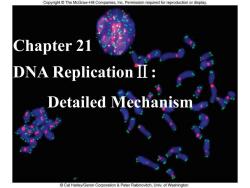
CopyrightThe McGraw-Hill Companies,Inc.Permission required for reproduction or display. Chapter 21 DNA Replication II Detailed Mechanism Cal Harley/Geron Corporation Peter Rabinovitch,Univ.of Washington
Chapter 21 DNA ReplicationⅡ: Detailed Mechanism
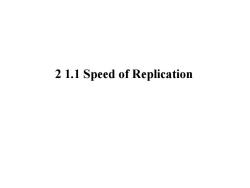
2 1.1 Speed of Replication
2 1.1 Speed of Replication

measure the rate of fork movement in vitro Primosome assembly site 00 Pol IlI holoenzyme +SSB a To create a synthetic circular template for rolling circle replication,This template contained a 32p-labeled tailed. At 10 sec intervals,they removed the labeled product DNAs and measured their lengths by electrophoresis
To create a synthetic circular template for rolling circle replication,This template contained a 32p-labeled tailed. At 10 sec intervals, they removed the labeled product DNAs and measured their lengths by electrophoresis. measure the rate of fork movement in vitro
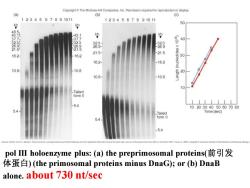
Copyright The McGraw-Hill Companies.Inc.Permission required for reproduction or display. (a) (b) (c) 1234567891011 1234567891011 他 50 2 431 9 7395 37.7 器8 16.2 162 21.5 30 162 16.2 10.8 108 20 108 108 Tailed form ll 1111I11 54 1020304050607080 Tailed Time (sec) form ll 54 -54 polⅢholoenzyme plus:(a)the preprimosomal proteins((前引发 体蛋白)(the primosomal proteins minus DnaG);or(b)DnaB alone.about 730 nt/sec
pol III holoenzyme plus: (a) the preprimosomal proteins(前引发 体蛋白) (the primosomal proteins minus DnaG); or (b) DnaB alone. about 730 nt/sec

Processivity(持续性):the ability of the enzyme to stick to its job a long time without falling off and having to reinitiate
Processivity(持续性): the ability of the enzyme to stick to its job a long time without falling off and having to reinitiate.
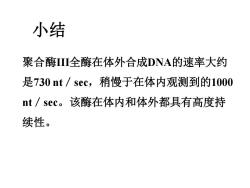
小结 聚合酶II全酶在体外合成DNA的速率大约 是730nt/sec,稍慢于在体内观测到的1000 nt/sec。该酶在体内和体外都具有高度持 续性
聚合酶III全酶在体外合成DNA的速率大约 是730 nt/sec,稍慢于在体内观测到的1000 nt/sec。该酶在体内和体外都具有高度持 续性。 小结

21.2 Initiation(起始) Initiation of DNA replication means primer synthesis.Different organisms use different mechanisms to make primers;even different phages that infect E.coli(coliphages)use quite different primer synthesis strategies. Priming(引发)lnE.coli M13 phage use the host RNA polymerase as its primase(primer-synthesizing enzyme).But E.coli and its other phages employ a primase called DnaG,which is the product of the E.coli dnaG gene.E.coli and most of its phages need at least one more protein (DnaB,the product of the E.coli dnaB gene)to form primers,at least on the lagging strand
2 1.2 Initiation(起始) Initiation of DNA replication means primer synthesis.Different organisms use different mechanisms to make primers;even different phages that infect E.coli(coliphages)use quite different primer synthesis strategies. Priming(引发)ln E.coIi M13 phage use the host RNA polymerase as its primase(primer-synthesizing enzyme).But E.coli and its other phages employ a primase called DnaG,which is the product of the E.coli dnaG gene. E.coli and most of its phages need at least one more protein (DnaB,the product of the E.coli dnaB gene)to form primers,at least on the lagging strand.
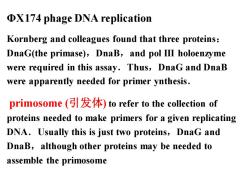
DX174 phage DNA replication Kornberg and colleagues found that three proteins: DnaG(the primase),DnaB,and pol III holoenzyme were required in this assay.Thus,DnaG and DnaB were apparently needed for primer ynthesis. primosome(引发体)to refer to the collection of proteins needed to make primers for a given replicating DNA.Usually this is just two proteins,DnaG and DnaB,although other proteins may be needed to assemble the primosome
ΦX174 phage DNA replication Kornberg and colleagues found that three proteins: DnaG(the primase),DnaB,and pol III holoenzyme were required in this assay.Thus,DnaG and DnaB were apparently needed for primer ynthesis. primosome (引发体)to refer to the collection of proteins needed to make primers for a given replicating DNA.Usually this is just two proteins,DnaG and DnaB,although other proteins may be needed to assemble the primosome
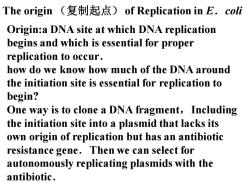
The origin(复制起点)of Replication in E.coli Origin:a DNA site at which DNA replication begins and which is essential for proper replication to occur. how do we know how much of the DNA around the initiation site is essential for replication to begin? One way is to clone a DNA fragment,Including the initiation site into a plasmid that lacks its own origin of replication but has an antibiotic resistance gene.Then we can select for autonomously replicating plasmids with the antibiotic
The origin (复制起点)of Replication in E.coli Origin:a DNA site at which DNA replication begins and which is essential for proper replication to occur. how do we know how much of the DNA around the initiation site is essential for replication to begin? One way is to clone a DNA fragment,Including the initiation site into a plasmid that lacks its own origin of replication but has an antibiotic resistance gene.Then we can select for autonomously replicating plasmids with the antibiotic.
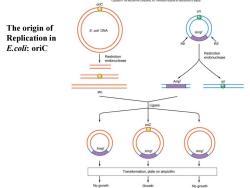
oric The origin of E.coli DNA Amp' Replication in RE E.coli:oriC Restriction Restriction endonuclease endonuclease Amp etc Ligase Amp Amp Transformation,plate on ampicillin No growth Growth No growth
The origin of Replication in E.coli: oriC
按次数下载不扣除下载券;
注册用户24小时内重复下载只扣除一次;
顺序:VIP每日次数-->可用次数-->下载券;
- 《分子生物学 Molecular Biology》课程教学课件(PPT讲稿,英文版)Chapter 20 DNA Replication I - Basic Mechanism and Enzymology.ppt
- 《分子生物学 Molecular Biology》课程教学课件(PPT讲稿,英文版)Chapter 18 The Mechanism of Translation II - Elongation and Termination.ppt
- 《分子生物学 Molecular Biology》课程教学课件(PPT讲稿,英文版)Chapter 17 The mechanism of translation I - initiation.ppt
- 《分子生物学 Molecular Biology》课程教学课件(PPT讲稿,英文版)Chapter 16 Other RNA Processing Events.ppt
- 《分子生物学 Molecular Biology》课程教学课件(PPT讲稿,英文版)Chapter 15 Messenger RNA Processing II - Capping and Polyadenylation.ppt
- 《分子生物学 Molecular Biology》课程教学课件(PPT讲稿,英文版)Chapter 14 Messenger RNA Processing I - Splicing.ppt
- 《分子生物学 Molecular Biology》课程教学课件(PPT讲稿,英文版)Chapter 13 Chromatin Structure and Its Effects on Transcription.ppt
- 《分子生物学 Molecular Biology》课程教学课件(PPT讲稿,英文版)Chapter 12 Transcription Activators in Eukaryotes.ppt
- 《分子生物学 Molecular Biology》课程教学课件(PPT讲稿,英文版)Chapter 11 General Transcription Factors in Eukaryotes.ppt
- 《分子生物学 Molecular Biology》课程教学课件(PPT讲稿,英文版)Chapter 10 Eukaryotic RNA Polymerases and Their Promoters.ppt
- 《分子生物学 Molecular Biology》课程教学课件(PPT讲稿,英文版)Chapter 08 Major Shifts in Prokaryotic Transcription、Chapter 09 DNA-protein interactions in Prokaryotes.ppt
- 《分子生物学 Molecular Biology》课程教学课件(PPT讲稿,英文版)Chapter 07 Operons - Fine Control of Prokaryotic Transcription.ppt
- 《分子生物学 Molecular Biology》课程教学课件(PPT讲稿,英文版)Chapter 06 The mechanism of transcription in prokaryotes.ppt
- 《分子生物学 Molecular Biology》课程教学课件(PPT讲稿,英文版)Chapter 05 Molecular Tools for Studying Genes and Gene Activity.ppt
- 《分子生物学 Molecular Biology》课程教学课件(PPT讲稿,英文版)Chapter 04 Molecular Cloning Methods.ppt
- 《分子生物学 Molecular Biology》课程教学课件(PPT讲稿,英文版)Chapter 01 A Brief History、Chapter 02 The Molecular Nature of Genes Molecular Biology、Chapter 03 An Introduction to Gene Function.ppt
- 《分子生物学》课程各章作业习题(含答案).docx
- 《分子生物学》课程授课教案(讲义,共二十一章).docx
- 海南大学:《生物统计学》课程授课教案(讲义,共十章).pdf
- 海南大学:《微生物生物学》课程授课教授.pdf
- 《分子生物学 Molecular Biology》课程教学课件(PPT讲稿,英文版)Chapter 22 Homologous Recombination.ppt
- 《分子生物学 Molecular Biology》课程教学课件(PPT讲稿,英文版)Chapter 23 Transposition(转座).ppt
- 新疆大学:《细胞生物学》课程教学大纲 Cell Biology(生科生技专业,负责人:计巧灵).doc
- 新疆大学:《细胞生物学》课程教学资源(教案讲义)教案1-1.doc
- 新疆大学:《细胞生物学》课程教学资源(教案讲义)教案2-1.doc
- 新疆大学:《细胞生物学》课程教学资源(教案讲义)教案2-2.doc
- 新疆大学:《细胞生物学》课程教学资源(教案讲义)教案2-3.doc
- 新疆大学:《细胞生物学》课程教学资源(教案讲义)教案3-1.doc
- 新疆大学:《细胞生物学》课程教学资源(教案讲义)教案3-2.doc
- 新疆大学:《细胞生物学》课程教学资源(教案讲义)教案3-3.doc
- 新疆大学:《细胞生物学》课程教学资源(教案讲义)教案4-1.doc
- 新疆大学:《细胞生物学》课程教学资源(教案讲义)教案4-2.doc
- 新疆大学:《细胞生物学》课程教学资源(教案讲义)教案5-1.doc
- 新疆大学:《细胞生物学》课程教学资源(教案讲义)教案5-2.doc
- 新疆大学:《细胞生物学》课程教学资源(教案讲义)教案6-1.doc
- 新疆大学:《细胞生物学》课程教学资源(教案讲义)教案6-2.doc
- 新疆大学:《细胞生物学》课程教学资源(教案讲义)教案7-1.doc
- 新疆大学:《细胞生物学》课程教学资源(教案讲义)教案7-2.doc
- 新疆大学:《细胞生物学》课程教学资源(教案讲义)教案8-1.doc
- 新疆大学:《细胞生物学》课程教学资源(教案讲义)教案8-2.doc
